Introduction:
Natural stone has been a popular choice for paving for thousands of years, but its place as the most popular choice was usurped in the early 20th century by the advent of concrete flags .
One of the biggest changes in paving over the last century has been the incredible increase in access to imported stone, whether it’s sandstone from India, granite from China, slate from Brazil or limestone from Egypt.
As a family's disposable income grew in the later decades of that century, the choice of concrete flags grew exponentially, and one of the most popular styles was concrete copies of those old, worn natural stone flags.
Concrete copies offer a number of advantages - they are cheap, compared to the genuine article; they can be cast to modular sizes, making patterns or coursing much simpler; they can be produced at fairly regular thicknesses, whereas natural stone might be anywhere from 30-100mm thick; and they can be packaged for sale via retail outlets other than Builder's Merchants.
As technology progressed, so the realism of the imitation riven flags improved, and, by the late 1990's, the copies had become so good that they were all but indistinguishable from the real thing.
The consumer was offered a wide range of 'qualities' from the cheap, utilitarian 450x450mm pressed units selling for under a tenner per square metre, through medium priced, multi-size ranges, and on to the top-of-the-range items, featuring realistic looking textures and colours and selling for 30 quid per square metre or more.
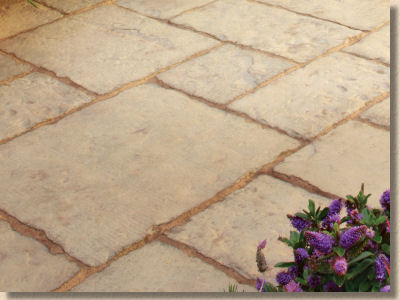
Then came the imports. Stone flags could be quarried, hand-dressed, packed and shipped from what we used to refer to as "developing countries" [1] for a fraction of the price of British or Irish sourced stone. In some cases, the packs of flags were literally being used as ballast aboard ships delivering other goods to the EU. And the market was ready for it!
The explosion of interest in 'lifestyle tv' had convinced many homeowners to carry outdoors those spending habits previously restricted to decor for inside the home, and we started hearing trendy garden designers spouting nonsense about making "outdoor rooms" [2], spending huge sums of money creating gardens and patios that might only be used for a couple of months of the year, but the market was primed and the people wanted to spend.
[1] - it seems they were primarily developing an interest in owning much of the infrastructure of allegedly developed countries
[2] - in some parts of the country, it is legal for anyone using this phrase to be smacked over the head with a spade
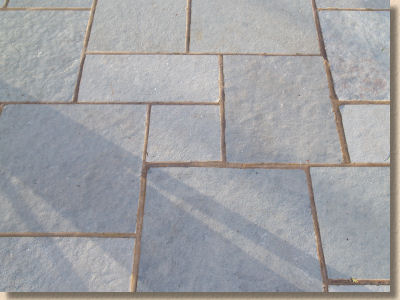
So, the two driving forces of supply and demand met head on and a new interest in patio paving took off.
Suddenly, genuine stone paving was available, in modular sizes, in convenient thicknesses (or thin-nesses, depending on your viewpoint), in a stunning range of colours and styles, and not only was it readily available for half the price of good old British York Stone , it was cheaper than the better quality concrete copies!
You could now buy genuine stone flags, brand new, hand-dressed, for 20 quid per square metre or less, and it was only the anoraks like me that could tell you that it wasn't 'real' york stone.
A World of Stone
And so, we are seeing more and more stone imported from more exotic parts of the world. Most noticeably, there has been a surge in the supply of an Indian Sandstone which sells under a bewildering array of names, some attempting to sound vaguely "Northern", even though the stone has never been anywhere near the north of Britain, while others emphasise their sub-continental origins with names like "Raj Green" or "Modak".
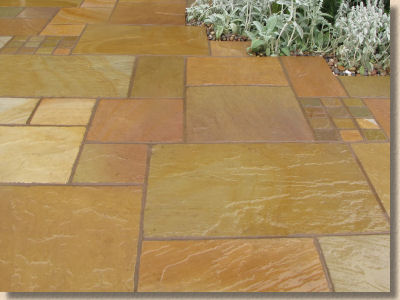
There are also granites from China and Brazil, marbles, porphyry, limestones , travertines and slates from southern Europe, all supplied as what we would term 'flagstones', as well as cubes, setts and cobbles in hardstones such as granite, gabbro and diorite.
The lower section of this page considers the more popular imported stones.
Quality and suitability
There's a tendency for some less reputable traders to supply the imported sandstone as 'York Stone', when the nearest it as ever been to that county is probably the dockside at Hull.
While much of what is imported is of reasonable quality, there is some shi rubbish that is barely capable of holding itself together.
When buying imported stone, always check the competence, that is, how well cemented together are the grains, how 'tough' is the stone. A simple check is to attempt to crumble a corner of a flagstone between the forefinger and thumb. The poor quality material will disintegrate under pressure, leaving grains of sand on the fingers.
Check also for delamination. Although increasingly rare, some of the cheap crap that is still sneaked into the country flakes into its individual layers or 'laminae' when exposed to the drizzle and damp of the British and Irish climate.
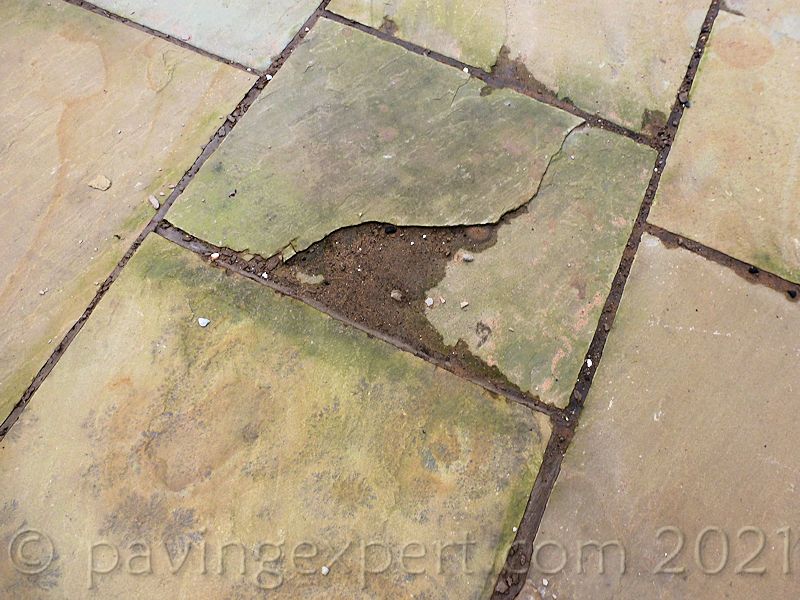
Quality Grades
There are several different grades of quality.

The best stone is sold as Firsts, and this tends to be very good quality suitable for all sorts of projects. Increasingly, this stone is bought up by the 'brand name' suppliers for their premium ranges or for use on commercial projects where quality thresholds are higher or may even be governed by the British or European Standards

Then comes the Seconds, which may not be as neatly finished, or is a less attractive type of stone, but is, generally speaking, more than adequate for the vast majority of patio projects. This stone is often sourced by smaller, independent distributors who understand their customers are primarily concerned with affordability and, as long as the quality is 'reasonable', don't worry too much about the stone being the very best.
Some of the 'seconds' rated stone will find its way into secondary processing plants, where relatively cheap stone can have its value uprated by being brushed or polished or honed.

And then there's the Seconds Rejects, which varies enormously in quality, from 'not too bad' to 'truly abysmal'. This grouping includes anything and everything that can't be crow-barred into one of the higher value groups. Seen really cheap stone flags on an internet auction site or a iffy-looking website. See if you can work out what grade of material it is they are selling!
Much of the smaller flagstones, setts and so-called cobbles are prepared from this poorer grade of material.
It should be noted that most suppliers, distributors or dealers will not reveal the exact grade of their stock, and in many cases, price is not always a reliable indicator. We have seen dreadful imported sandstone selling for £30 per m², and we have seen a gorgeous deep red sandstone that is as hard-wearing as any Yorkstone but sells for a mere £14 per m²
Performance
Obviously, because the vast majority of this stone has been around for only a couple of decades or so, it's difficult to say how it will perform in the long term, or how good it is at coping with British/Irish winters and the near-perpetual damp we have to endure, but there are valid concerns regarding algaefication , where the stone seems to go green almost overnight as its porous surface is readily colonised by algae and lichens.
See Cleaning Paving page for notes on cleaning algae and lichens
A notable point that was brought up in the Brew Cabin Discussion Forum on this site is that much of this imported material has undergone no form of approved testing, so data for Water Absorption, Slip Resistance, Compressive Strength etc., may not be readily available, especially with the cheaper sources. This lack of information may render them unacceptable as new paving on certain civic or commercial projects. However, the better quality importers will be able to provide data on request.
Sizes
One very important point that should be noted, by both contractors looking to lay these flags and clients looking to buy them for their homes, is that the sizings can be a bit strange, to say the least. While most of these flags are generally 15-30mm in thickness (see calibrated materials below), which does have an effect on laying methodology , it's the plan sizes that have a direct bearing on design , layout and patterns .
There are no hard-and-fast rules about what sizes can or cannot be supplied. Some suppliers will offer 200x200, 200x400, 400x400, for example, while others follow more orthodox sizing schemes. Similarly, some ranges are sized in imperial units (inches) rather than metric (millimetres or centimetres).
With Indian Imported Flagstones, there are two distinct 'schools' of sizes: the 600 series and the 560 series.
It's not possible to say that one size-option or 'series' is better than the other, or is easier to lay, or simpler to order. There is no real difference other than sizing.
As a forcibly-retired contractor, I would opt for the 600 series for two reasons:
- It's easier to calculate widths, lengths and coverage using the 'rounded figures' associated with the 600 series
- More ground is covered with each flag placement, so, in theory, there's less bending and handling of individual units per square metre of completed work
Generally speaking, the flags of both series are modular, which means they can be used in conjunction with others of the same series to create patterns and layouts, but the two series are NOT interchangeable. It's not a good idea to mix 560 series flags with 600 series. The result will look bloody awful!
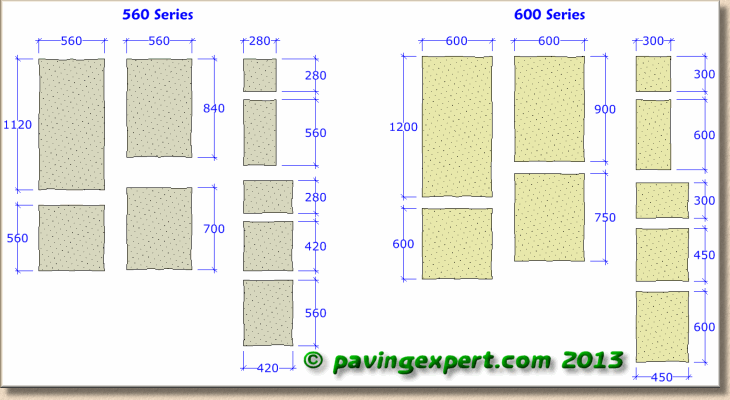
It's also important to note the following:
- Not all sizes will be offered by all suppliers
- Many suppliers will offer only three or four of the shown sizes from either range
- Some suppliers offer sizes not shown above, such as 1200x900mm or 840x840mm
- Some suppliers get cute with the smaller sizes and provide a 290x290 in place of a 300x300
- This has no real benefit when creating random layouts but is useful for other patterns
However, some of the flags on offer in the darker corners of our world and the interweb seem to follow a non-logical set of dimensions. We've seen 560x400mm units and 750x560mm, which don't seem to fit into any modular scheme. Indeed, some ranges are completely baffling and result in dramatically uneven joint widths when laid to random layouts rather than coursed layouts, as can be seen in the image opposite.
It has to be admitted that some of these oddities come about because unscrupulous dealers throw together all the bits and bats they have left over. They may be suitable for coursed work ( gauged width by random length , for example)
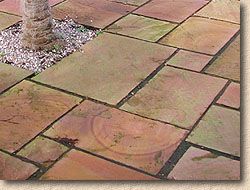
So, when sourcing these flags, check on available sizes, and whether they are modular. If you're laying coursework, then it's not as critical as it would be for a random or patterned layout.
The most popular sizes seems to be based on the following sets, and the flags in the range are, roughly ± 5mm of the sizes shown in the table below...
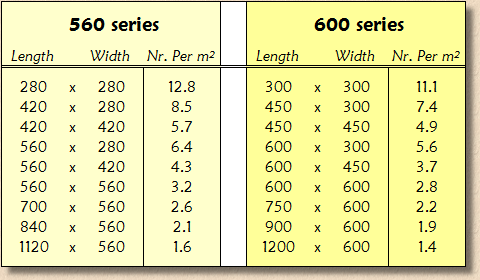
570mm flags???
More or less every week, someone calls or emails to insist that the flagstones they have are 570mm. Or they are 285mm and 430mm and 570mm and 855mm.
No they are not! If they are, someone has sold you a pack of duds, because no reputable processor manufactures to a 570mm module.
What happens is wily suppliers in Britain (fewer in Ireland) claim that the flags they supply are these sizes, but then, in the teeny-weeny-tiny print there'll be a feint note to the effect of "the stated dimensions assume a 10mm joint width ".
In layman's terms, this means the flags are actually 560mm but the supplier has added 10mm to make them seem bigger.
They've then calculated the total area those flags would cover if laid with this hypothetical 10mm joint, which, because it includes empty space, is noticeably bigger than the area the flags would actually cover if laid tight against one another.
Consequently, unwitting punters think they are somehow getting more flag for their money.
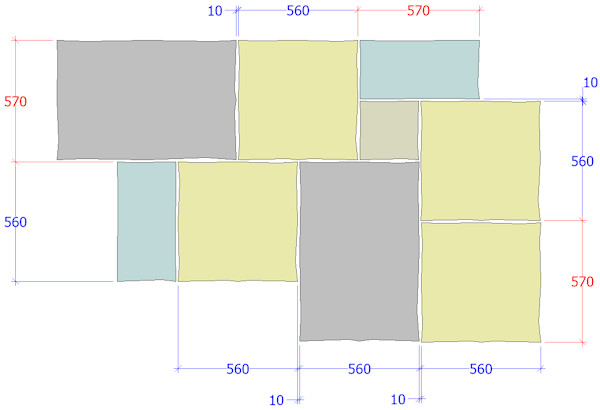
In truth, you are being sold fresh air....at 20-odd quid a square metre!!!
If a supplier can claim their pack covers , say, 18m² but this includes an undeclared 1m² of 'jointing', it would seem a better deal than a pack offering a solid 17m² of flagstone. Except that it's not!
What's to stop another, less scrupulous manufacturer allowing for, say, a 25mm joint and then claiming their pack covers 19.5m²? It's just WRONG!
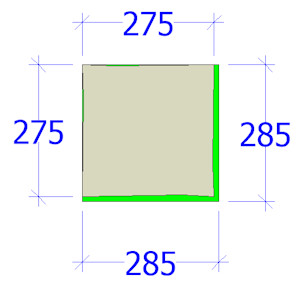
For a flag that's 275mm x 275mm, claiming it to be 285 x 285mm is adding a non-existent 56 cm² per piece....a whopping 7.4% of buggerall!
So: if your supplier says the flags are 570mm (or 285/430/845mm etc.) they are being less than honest. How would they feel if you snipped-off 7.4% from their bill?
Calibrated Flagstones
As lovely as natural stone can be, in its native riven format the biggest problem from an installer's point of view has always been the variation in thickness.
Some flags might be only 15mm or so, while others could be 40mm or more.
The photie opposite shows typical variation in uncalibrated flags intended for residential projects.
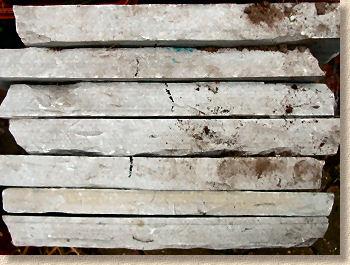
Some of the more upmarket brands have started to supply riven natural stone of a regular thickness, and that regular thickness is created using a process known as 'calibration' or 'strip milling'.
Calibrated paving, whether it's flagstones or setts, can usually be identified by the series of parallel grooves or strips on the underside caused by a mill saw.
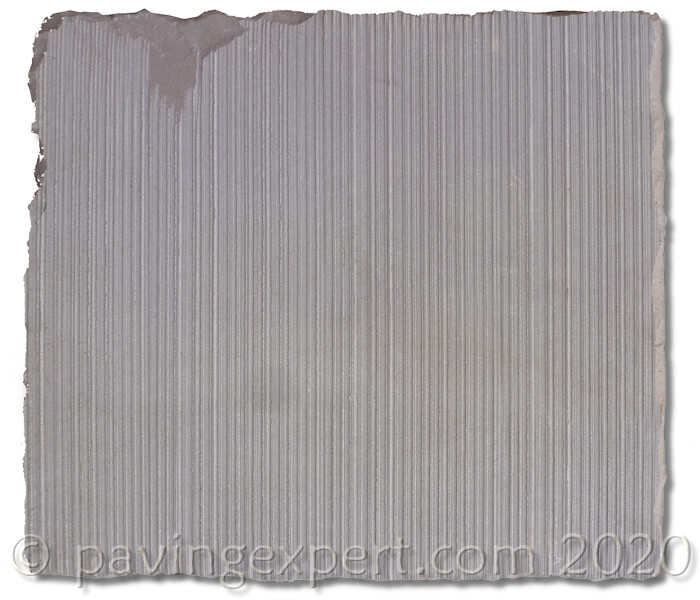
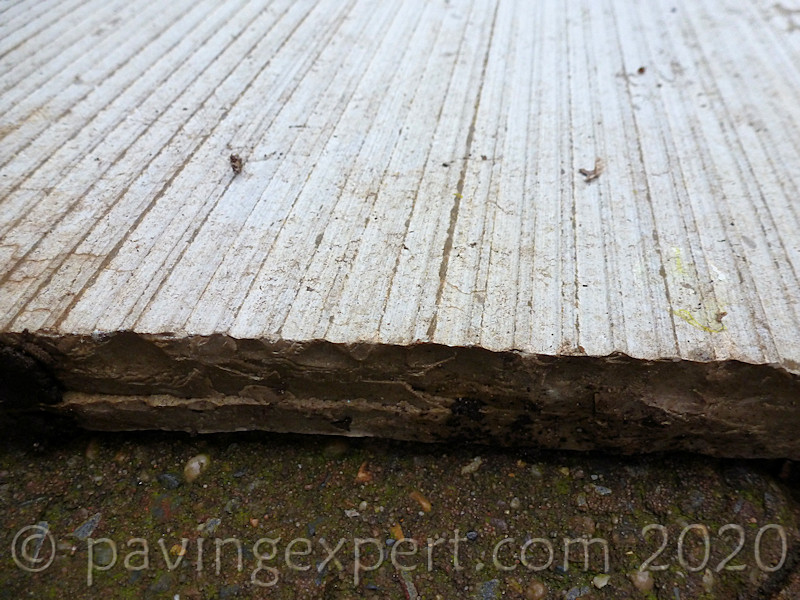
The alleged advantage of calibrated stone is that it allows a screeded bed to be used rather than the more fussy and time-consuming individual bed , and so offers a faster installation .... in theory. In practice, the amount of time saved by using a calibrated material with a screeded bed is minimal. It is measured in minutes rather than hours, and that assumes it is being laid by a professional installer.
Further, to take full advantage of screed bedding, the installer needs to be proficient not only with screed preparation but also with getting flags laid quickly and accurately. This is often something of a challenge for DIYers and 'occasional' installers, and so any projected time-saving is mythical, at best, and impossible in many instances.
On basic, single-plane jobs, the flag-laying task may be simplified by using a screeded bed, but how many jobs are like this? It cannot accommodate changes in gradient, multiple or complex falls, summaits and valleys, and the like.
The less commonly noted issue with screeded bed laying is that it seeks to eliminate the skills required to prepare an accurate individual bed, and so, problems occur where twists, summits and valleys, and reverse or complex falls are required, and it's usually necessary to revert to individual bedding for such areas.
Naturally, all this convenience comes at a price - calibrated materials typically sell for 20-30% more than non-calibrated stock.
Project Packs
Increasingly, imported natural stone for residential paving projects such as patios and driveways is being sold as Project Packs or Patio Packs.
These pre-packed pallets of flags contain a set number of flagstones with fixed quantities of each particular size. A typical Project Pack might contain....
- 13 pieces @ 900x600mm
- 13 pieces @ 600x600mm
- 13 pieces @ 600x300mm
- 9 pieces @ 300x300mm
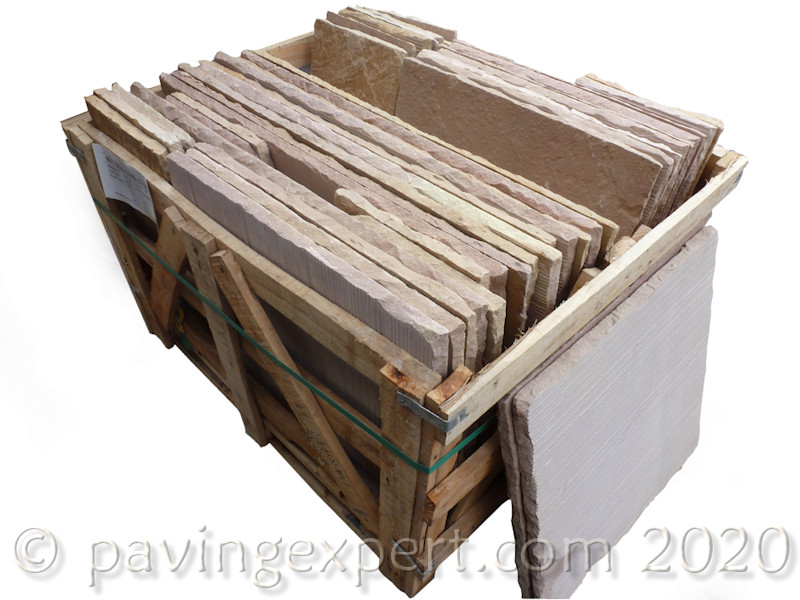
...which is a common ratio for run-of-the-mill value-for-money nowt-special Project Packs, which, by using a readily available random layout plan, can be assembled to give a 15-ish m² rectangle roughly 4.6m x 3.3m.
When a larger area is needed, or the actual job involves laying a mixture of paths and seating areas, features and steps, then multiple packs can be used together to cover any area, any shape.
Working out which flag should go where in anything more complicated than the basic rectangle mentioned above needs careful planning to determine which flag of what size should go where for best effect. Good layout design will create an attractive mix of sizes, shades and textures to show off the paving to best effect, whilst minimising both wastage and cutting. This is the true art of a good pavior or streetmason: knowing which to put where and just as importantly, knowing why.
Other Project Packs contain all the parts required to construct a particular feature, such as a circle , a decorative compass or set of steps. With some product ranges, feature sets are supplied as 'add-ons' to rectangular packs, enabling clients to pick-and-choose a particular look or style for a range of hard-landscaping and so individualise their project.
At its worst, it is kit-form home landscaping, but at its best, Project Packs offer quality product in a considered and versatile style at an affordable price.
Spoiled for choice...
What follows is a selection of photographs illustrating some of the more popular imported sandstones that are available through a selection of the better quality suppliers. All these images were taken by myself, or by friends of the website, with the intention of portraying the stone as realistically as is possible on a web page. There's no trick photography, no arty-farty designer styling, no fancy lighting - just photos of the stone flags as they appear in the display areas of the named suppliers.
It is strongly recommended that you visit a supplier and see the stone laid out as shown here before making a purchase. Buying from photos, catalogues or looking at one or two flags dragged from a rickety wooden crate is not a good idea. All of the suppliers listed here are delighted to welcome visitors to their premises and to show buyers a wide range of stone paving to make sure they get the stone best suited to their tastes and their pockets.
This page features mostly sandstone flags. Subsequent pages will feature other types of stone flags, including limestones, granites, whinstone, slate and more.
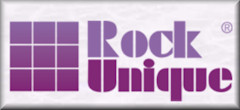
Rock Unique, based just outside Sevenoaks in Kent, have scoured the world to find quality stone paving materials.
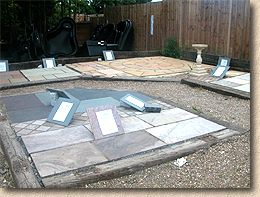
This is a small selection from their range of Indian Sandstone flags. Rock Unique carry one of the most comprehensive inventories of stone for paving and flooring in Britain and a visit to their sales office just at the end of the M25 spur to Sevenoaks is time well spent, as the ever affable Chris and Mike can show you a range of stone that it's just not possible to illustrate on this one page.
Rock Unique - Sevenoaks 01959 565608
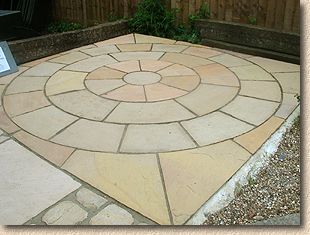
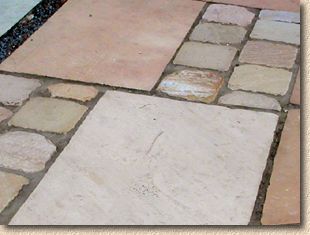
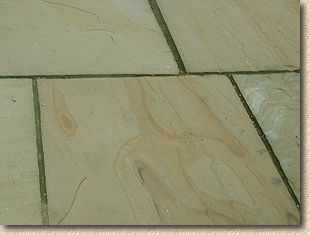
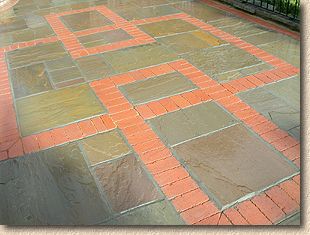
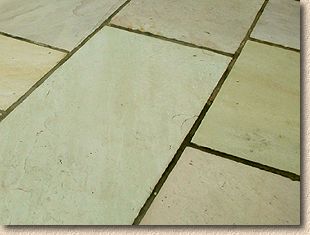
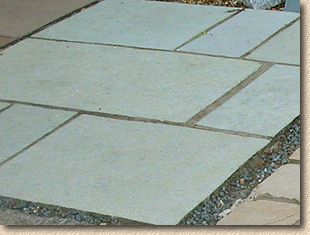
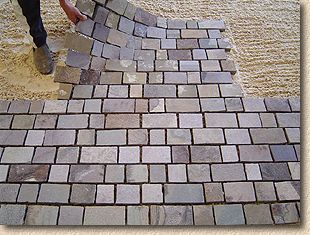
One of the more intriguing products from Rock Unique are there mesh-backed porphyry setts.
The setts are cut, dressed and mounted onto a strong polypropylene mesh backing, so that, when it comes to laying, all that needs be done is to prepare a level bed, drop the mesh setts into place, consolidate with a plate compactor and joint them! It really couldn't be easier!
More info from Rock Unique - 01959 565608
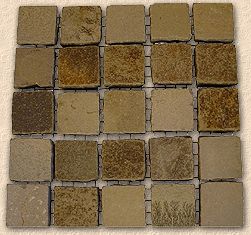
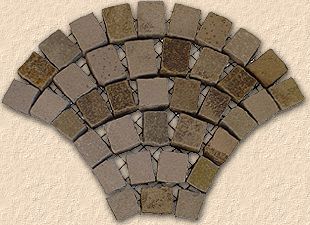
Flagstones from other importers
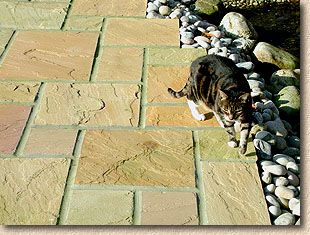
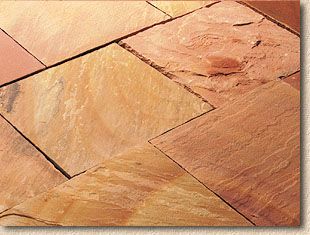
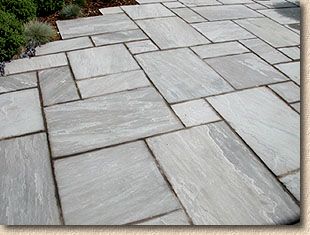
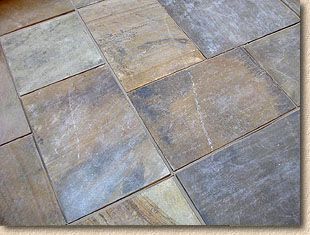
A selection of other flags, including sawn stone, which has a completely different texture and character from that of riven stone.
Riven paving has a more natural look, but its irregular surface is not to everyone's taste and some designers believe that the sawn/honed finish, which is smooth but NOT slippery (as some people seem to think), is better suited to modern, contemporary patio design, and the riven is best left to the traditional 'cottagey' look that remains popular with British and Irish garden lovers.
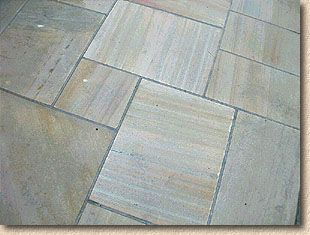
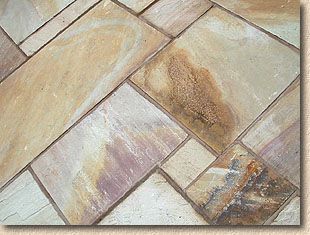
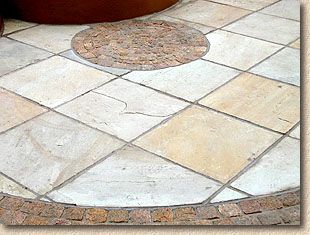
Circles
Circles are a popular feature, either built into larger patios or as stand-alone features within the garden. Many of the larger suppliers offer a range of circles, featuring a centre stone with one, two, three or more outer rings of pre-cut flags, giving a selection of different diameters.
All the circles featured here come as 'kits', that is, as complete sets with the requisite number of pieces required to form a whole circle, and some of the bigger suppliers also offer "Squaring-off Kits" as an optional extra. These squaring off kits provide the odd-shaped bits required to fit a circle feature into a rectangular "orthogonal" patio.
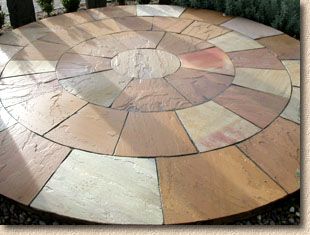
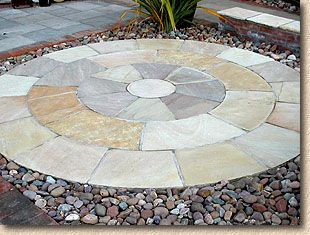
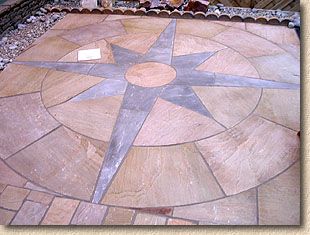
Fossils (allegedly)
Many suppliers offer flagstone featuring these intriguing 'Fossils', which, admittedly, do look like ferns or some other simple plant from pre-history, and are a fascinating talking point when the client is showing off their new patio. However, they are actually a trace stain, created by a reaction of metallic oxides within the stone that has lain buried for millions of years before being exposed to the atmosphere when the stone flag was cleaved in the quarry.
Still, it's a nice thought, and makes the flags even more attractive!
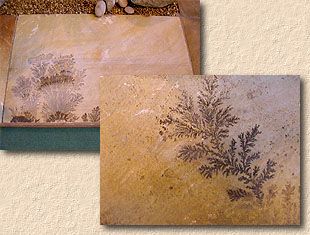
A warning about acid cleaners
Over the last few years, there have been a number of reports to this website regarding a frightening discolouration that can occur with some imported flagstones, setts, kerbs and associated items when washed with an acid or an acid-based cleaner.
These cleaners (also known as Patio Cleaners, Acid Washes, Brick Acid, Cement Remover and dozens more) generally contain 3-10% hydrochloric acid (HCl aka Muriatic Acid) and are commonly used to clean minor staining and, in particular, cement and mortar stains from newly laid pavements. This is a well-established practice with some other paving products, where it generally has no effect on the paving other than to get rid of the offending stains, so it generally comes as a surprise to the unwary contractor when what were a lovely light grey flag suddenly turn bright orange.
The problem is caused by a chemical reaction (you knew it would be!) between the hydrochloric acid and iron-based minerals that naturally occur within the stone.
Without getting bogged down in all sorts of complicated stuff about ions and covalent bonds, the acid causes the iron that was previously locked-away within the stone to be released and exposed on the surface. Sort of. Ish.
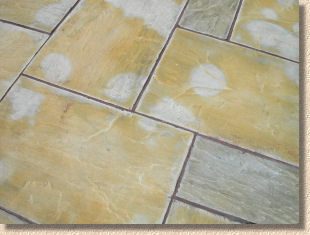
It doesn't affect all imported stone, and it seems that different batches of the same product react differently at different times. It's not been possible to collate comprehensive data as many of the suppliers haven't been too forthcoming about whether the stone they supply is affected, and if so how badly, and under what particular circumstances, but from the feedback to the website, it seems that...
- The lighter-hued sandstones are more susceptible than the darker ones
- The longer the acid is in contact with the stone, the worse the discolouration
- Stone that was pre-wetted before acid-washing is less severely affected
- The discolouration is stronger if the acid wash is undertaken in bright sunshine
- The stronger the acid (in %age), the worse the effect
....of course, this is very much a generalisation and individual experiences can, and do, vary.
At the moment, there is no known *guaranteed* fix, despite what some of the less trustworthy suppliers and contractors are telling fretful homeowners.
A sealant , even a bloody good sealant, will NOT make this effect disappear.
The claim that Oxalic Acid will reverse the effect remains unproven, but it does seem to reduce the visual impact of the lightest stains.
Grinding, shot blasting, and other abrasive treatments can reveal a 'clean' face but they may also dramatically and irreversibly alter the texture of the stone. Further, stone that has been well and truly soaked with acid in an attempt to get rid of heavy cement staining, the discolouration effect continues for several millimetres into the body of the stone, so abrasive treatment can be futile.
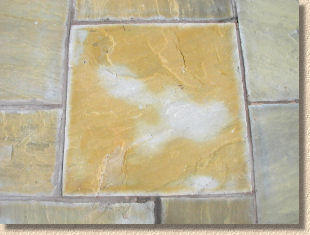
The only sure and certain method of avoiding this problem is not to use acid in the first place! When stone paving requires cleaning, use household bleach diluted to 50% with clean water. To get rid of cement or mortar stains, rely on mechanical action wherever possible.
